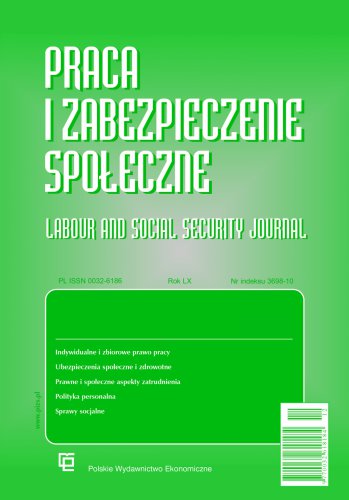Legal mechanisms ensuring protection of the on-call workers in the selected EU jurisdictions in the light of implementation of Directive 2019/1152 to the Polish legal system
This article aims to analyze the legislation in selected EU countries in the light of the Directive 2019/1152. The author focuses on the provisions of the Directive which are to improve the on-call workers protection standards. Based on the presented studies, the author also attempts to formulate the conclusions concerning the implementation of the Directive into Polish legal system.
References
Bibliografia/References
Bąk, E. (2006). Elastyczne formy zatrudnienia. Biblioteka Monitora Prawa Pracy.
Burri, S., Heeger-Hertter, S. i Rossetti, S. (2018). On-call work in the Netherlands: trends, impact, and policy solutions. Conditions of Work and Employment Series. No. 103. Geneva: International Labour Organization. https://www.ilo.org/wcmsp5/groups/public/---ed_protect/---protrav/---travail/documents/publication/wcms_626410.pdf (10.01.2022).
Chobot, A. (1997). Nowe formy zatrudnienia. Kierunki rozwoju i nowelizacji. Wydawnictwa Prawnicze PWN.
Chobot, A. (2003). Czas pracy w znowelizowanym kodeksie pracy. Wydawnictwo Poznańskie.
De Stefano, V. (2016). Casual Work beyond Casual Work in the EU. European Labour Law Journal, 7(3). https://doi.org/10.1177/201395251600700307
Eurofound (2015). New forms of employment. Luxembourg: Publications Office of the European Union. https://www.eurofound.europa.eu/sites/default/files/ef_publication/field_ef_document/ef1461en.pdf (22.12.2021).
Gyulavari, T., Kartyas, G. (2014). The Hungarian Flexicurity Pathway? New Labour Code after Twenty Years in the Market Economy. Pazmany Press. https://www.researchgate.net/profile/Tamas-Gyulavari2/publication/321803594_THE_HUNGARIAN_FLEXICURITY_PATHWAY_New_Labour_Code_after_Twenty_Years_in_the_Market_Economy/links/5a327a32458515afb6f65ab9/THE-HUNGARIAN-FLEXICURITYPATHWAY-New-Labour-Code-after-Twenty-Years-in-the-Market-Economy.pdf (23.12.2021).
Komisja Europejska (2007). Communication from The Commission to the European Parliament, The Council, The European Economic and Social Committee and The Committee of the Regions Towards Common Principles of Flexicurity: More and better jobs through flexibility and security, COM(2007) 359 final. Bruksela. https://eur-lex.europa.eu/LexUriServ/LexUriServ.do?uri=COM:2007:0359:FIN:EN:PDF (22.01.2022).
Komisja Europejska (2017a). Second phase consultation of Social Partners under Article 154 TFEU on a possible revision of the Written Statement Directive (Directive 91/533/EEC) in the framework of the European Pillar of Social Rights, C(2017) 6121 final. Bruksela. https://ec.europa.eu/social/main.jsp?pager.offset=10&catId=522&langId=en&moreDocuments=yes (15.01.2022).
Komisja Europejska. (2017b). Commission Staff Working Document Impact Assessment Accompanying the document Proposal for a Directive of the European Parliament and of the Council on transparent and predictable working conditions in the European Union, SWD (2017)478 final. Bruksela. https://eur-lex.europa.eu/legal-content/EN/TXT/?uri=CELEX:52017SC0478 (21.12.2021).
Komisja Europejska (2018). Gaps in access to social protection for casual workers in Romania: case study. Publications Office. https://data.europa.eu/doi/10.2767/077572 (08.01.2022).
Komisja Europejska (2019a). Factsheet: Towards transparent and predictable working conditions. http://ec.europa.eu/social/BlobServlet?docId=20696&langId=en (15.01.2022).
Komisja Europejska (2019b). Przejrzyste i przewidywalne warunki pracy w UE. https://eur-lex.europa.eu/legal-content/PL/LSU/?uri=celex:32019L1152 (28.12.2021).
Nowak, M. (2020). 10.2. Prawo wtorne — Dyrektywa 91/533/EWG. W: K. W. Baran (Red.), System prawa pracy. Tom X. Międzynarodowe publiczne prawo pracy. Standardy europejskie.
https://sip.lex.pl/#/monograph/369461449/380152?tocHit=1&cm=RELATIONS (11.01.2022).
Projekt Kodeksu Pracy opracowany przez Komisję Kodyfikacyjną Prawa Pracy. (2018). https://www.gov.pl/web/rodzina/bip-teksty-projektu-kodeksupracy-i-projektu-kodeksu-zbiorowego-prawa-pracy-opracowane-przez-komisje-kodyfikacyjna-prawa-pracy (04.05.2022).
Rycak, M. (2011). Wpływ koncepcji flexicurity na przemiany stosunku pracy. W: L. Florek (Red.), Współczesne problemy prawa pracy i ubezpieczeń społecznych. LexisNexis.
Surdykowska, B. (2018). Projekt dyrektywy w sprawie przejrzystych i przewidywalnych warunków pracy w UE — element implementacji Europejskiego filaru praw socjalnych. Monitor Prawa Pracy, (3).
Świątkowski, A. M. (2020). Dyrektywa 2019/1152 — przejrzyste i przewidywalne warunki pracy w Unii Europejskiej, cz. 2. Europejski Przegląd Sądowy, (7).
Tiraboschi, M. (2005). The Italian Labour Market after the Biagi Reform. International Journal of Comparative Labour Law and Industrial Relations, 21(2), 149–192. http://old.adapt.it/adapt-indice-a-z/wp-content/uploads/2013/09/Tiraboschi_Journal.pdf (07.01.2022). https://doi.org/10.54648/IJCL2005009
Unterschütz, J. (2021). Europejski Filar Praw Społecznych — godna praca w ramach platform cyfrowych. W: B. Godlewska-Bujok i K. Walczak (Red.). Zatrudnienie w epoce postindustrialnej. Warszawa: C.H.Beck.
Wilthagen, T. i Tros, F. (2003). The Concept of Flexicurity: A new approach to regulating employment and labour markets. Tilburg: Flexicurity Research Papers, (4). https://doi.org/10.1177/102425890401000204 (22.01.2022).

